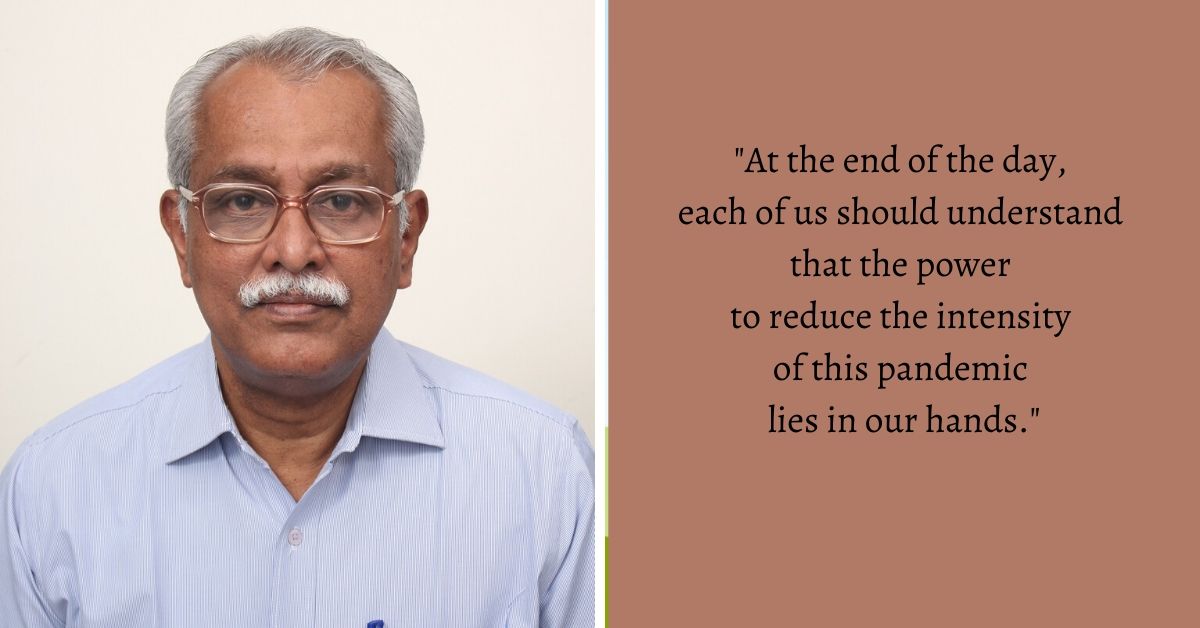How Can I Defeat COVID-19? Leading Epidemiologist Shares Steps For The Future
By following simple rules of handwashing, wearing masks, and physical distancing, each of us can make a difference, and help save thousands of lives.

Last week, newspapers were filled with hope as different countries started charting out their plans for opening up their lockdowns. Here, in India, as we work on this masterplan for 1/8th of the world population, we must consider several complications.
But, while that is ongoing, what can each of us do?
“At the end of the day, each of us should understand that the power to reduce the intensity of this pandemic lies in our hands,” says Dr Jayaprakash Muliyil. He is India’s leading epidemiologist and former principal of the Christian Medical College in Vellore, Tamil Nadu.
He continues, “We will fight this pandemic together. I don’t like the phrase ‘social distancing’. What is important is ‘physical distancing’, i.e. keeping 1-2 meters of distance from each other to stop the transmission of this new coronavirus that spreads from person to person through droplets. If we keep away from other people, the virus cannot spread. Each individual can make sure this transmission is not easy.”
In most instances, data from around the world have shown that the virus causes mild symptoms. “But in certain people, it develops into a severe illness where there is an inappropriate immune response against the virus,” Dr Muliyil explained.
As with many infectious diseases, with time, the number of people who have immunity to the virus increases.
“We start with 100 per cent people who are vulnerable to the disease. Over days, weeks, and months, the proportion of people who are infected, increases. And those susceptible, decreases. At this point, when the virus finds it difficult to find a new host, the community is said to have reached ‘herd immunity’. This is when the outbreak will cease.”

The proportion of people in a community who need to be immune to the disease for the entire population to be protected is different for different diseases.
“For COVID-19, my estimate is around 60-70 per cent. This means that if 60 per cent of people are immune to COVID-19, the viral transmission will stop, and the entire community will be protected.”
The best way to reach this 60 per cent, and thus herd immunity for COVID-19, without actually infecting a large part of the population, is by mass vaccination. “We have achieved herd immunity through vaccination for many diseases such as measles.”
By vaccinating a lot of people, not only do we reach herd immunity, but we also protect those who can’t be vaccinated, for example, small children, older people, pregnant women, as well as those with weak immune systems.
“Herd immunity is a difficult concept–how X & Y getting infected/vaccinated can lead to Z being protected. And it is equally difficult to reach herd immunity. The calculation of herd immunity depends on several factors, including how infectious the virus is. For example, the herd immunity required for measles is around 95 per cent, which means that unless 95 per cent of the population is immune, measles will find a susceptible person. For influenza, even with 40 per cent of people infected, the virus loses the battle.”
So, eventually, we want to reach herd immunity for COVID-19. But we can’t do this fast because this will cost a lot of lives.
“So rapid attainment of herd immunity by infection is not an option,” Dr Muliyil emphasised. An ideal way to achieve community protection would be by mass vaccination, but this will take several months, as scientists race to develop an effective and safe vaccine for COVID-19. Of course, one critical thing we must remember–all of this is based on the assumption that once a person is infected or vaccinated, they are protected. While this is true for most bacteria and viruses, scientists are still trying to establish this for the novel coronavirus.”
So, what do we do in the meantime?
“We need to slow down the pandemic.”
By following simple rules of handwashing, wearing masks, and physical distancing, each of us can make a difference, and help save thousands of lives. Slowing down the pandemic by reducing transmission is also what the lockdown is achieving.
“But the lockdown can’t get rid of the virus. And the lockdown can’t last forever. No country can afford this,” exclaimed Dr Muliyil.
Also Read: Fighting COVID-19: Experts Answer 5 questions We All Have About Wearing Masks
So, as the world’s largest democracy slowly weighs its exit strategy from the lockdown, it is critical for us to:
- continue practising good hygiene and physical distancing when outside to slow down the spread of the disease; and
- keep the elders and the vulnerable from getting infected by practising good hygiene and physical distancing even within families. This will reduce the burden on health systems by decreasing the number of severe cases and also reduce the disease mortality.
(Edited by Shruti Singhal)
Like this story? Or have something to share?
Write to us: [email protected]
Connect with us on Facebook and Twitter.
This story made me
-
97
-
121
-
89
-
167
Tell Us More
We bring stories straight from the heart of India, to inspire millions and create a wave of impact. Our positive movement is growing bigger everyday, and we would love for you to join it.
Please contribute whatever you can, every little penny helps our team in bringing you more stories that support dreams and spread hope.



















